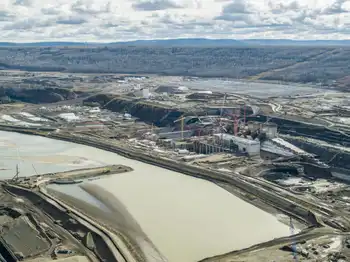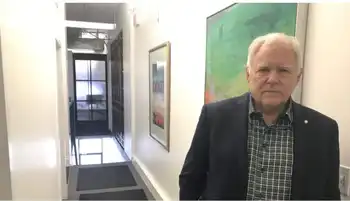Piles of poison PCBs remain across Ontario
By Toronto Star
Arc Flash Training - CSA Z462 Electrical Safety
Our customized live online or in‑person group training can be delivered to your staff at your location.

- Live Online
- 6 hours Instructor-led
- Group Training Available
The mound has been there for 22 years, all 22,000 tonnes, a contaminated lump of soil largely forgotten by the community that surrounds it. It's the biggest dump of its kind in Ontario, but it's not alone. There are 23 similar sites across the province, all containing a nasty blend of dirt and polychlorinated biphynls, or PCBs, a chemical cocktail first manufactured in 1929.
PCBs were once widely used in inks, lubricants, paints and certain types of electrical equipment, such as transformers. After several decades of use researchers discovered that high-level exposure to the chemical could increase the risk of kidney and liver cancers, cause birth defects and developmental problems in children, and affect human reproduction. The evidence became so compelling that the manufacture and sale of PCBs was banned across North America in the late 1970s.
But PCBs wouldn't go away so easily. The chemical is slow to degrade and difficult to destroy, meaning PCBs already existing in the market, or which had leaked into the environment from equipment or manufacturing facilities, had to be rounded up and safely stored-out of sight and harm's way. After more than three decades the legacy of PCBs lives on, often unbeknown to the communities that host them.
Jem Cain, who lives south of the West Toronto PCB soil dump, says the time has come to get rid of the contaminated mound once and for all. "There are families just up the street from it," she said.
The dump holds enough toxic soil to fill four Olympic-sized swimming pools. It sits in a neighbourhood called Alderwood deep within an abandoned lot near the corner of Browns Line and Horner Ave. — just two kilometres southeast of Sherway Gardens shopping mall and less than 200 metres from the nearest home. A tall wooden fence surrounds it, keeping it hidden away from casual passersby.
"I know it makes some people in the area nervous," said Lina Cino, who researches industrial toxins and pollution for the Toronto Environmental Alliance. The anxiety is understandable. PCBs absorb easily through the skin, and can also get into the body through food-for example, vegetables grown on PCB-contaminated soil or fish exposed to PCBs that have leached into creeks and made it into larger rivers and lakes. Once inside the body it persists and accumulates over time.
Storage sites for PCB-contaminated soils are still legal in Canada-kind of. Federal regulations passed two years ago called for the elimination of PCB dumps by December 31, 2009. The rules required that soils be shipped to one of a handful of certified destruction sites, including a major operation in Saint Ambroise, Quebec. Those designated destruction sites have until the end of 2011 to destroy the PCBs. This is typically done by incinerating the soil, which forces the PCBs to break down into more benign molecules.
But the 2009 deadline came and went, and many owners of PCB storage sites decided not to ship their soils for destruction. Technically they were breaking the law, though that wasn't their intention. The federal government had introduced an amendment to the regulations that would give site owners the option of keeping their dumpsites, as long as they agreed to eliminate the PCBs themselves by the end of 2011. The idea was that site owners could use new technologies to destroy the PCBs on site, sparing them the hassle and huge cost of transporting the soils to Quebec by truck.
There was one problem, however. The amendment didn't come into force until March 11 of this year. That left many PCB site owners in legal limbo for at least 10 weeks, and deflated the hopes of citizens anxious to see the dumps go.
David McGuinty, federal Liberal environment critic, called it "unacceptable" that the Harper government would leave industry in a regulatory no-man's land for so long. "We're putting these companies in a very difficult situation," said McGuinty. "My first reaction is that this is incompetence."
Officials from Environment Canada declined repeated requests for an interview. In response to questions sent by e-mail, department spokespeople would not confirm or deny that PCB site owners had broken the law.
The Canadian subsidiary of energy infrastructure giant Schneider Electric is one of those companies left in limbo. It is responsible for the PCB soil dump in west Toronto. The site was originally owned by Federal Pioneer Ltd., which manufactured and repaired electrical transformers from 1964 to when the PCB ban took effect in 1977. Excavation began in the 1980s and most of the contaminated soil was in long-term storage by the time Schneider acquired Federal Pioneer in 1990.
What Schneider plans to do at the site remains unclear. Schneider told the Star that it sent a letter to Environment Canada last May requesting that the site be designated an ongoing "restoration" project, which if approved would exempt it from disposal deadlines. To qualify, Schneider is supposed to tell the government when restoration work started, when it will be complete, and when the storage of the soil will no longer be required. Environment Canada confirmed that it received the letter but refused to disclose details, citing privacy rules.
It doesn't appear Schneider has a plan. The Star visited the soil dump earlier this year and saw no evidence of restoration. Two enforcement officers from Environment Canada also inspected the site in mid-February, a department spokesperson acknowledged in an e-mail on March 18. The officers, according to the e-mail, requested "submission of plans for the PCB soils once the proposed regulatory amendments come into force."
Schneider spokesperson Louise Jones confirmed that the status of the site has not changed. The restoration work has not yet begun, she said in an earlier email. "We cannot confirm an end date for restoration completion." The company also has no idea how it plans to destroy the PCBs. "Our method of restoration, which would need to be approved by the Ministry of Environment, has not yet been determined for the site. We are awaiting guidance."
Meanwhile, residents surrounding the soil dump must wait even longer before seeing it go. They also face the prospect now of having the PCBs destroyed in their own backyard.
"If they Schneider decide to destroy it on-site, what technologies would they use?" said Cain, who wonders whether on-site destruction - using, for example, a portable incinerator - could release chemicals into the surrounding environment, if not done properly.
Ontario's Ministry of the Environment assures that the west Toronto soil dump is safe for the time being, and is regularly monitored. Ministry spokesperson Kate Jordan said the site is encased in three layers of geosynthetic membrane, a durable plastic liner that doesn't degrade when exposed to soil or harsh weather. "There's also an active pump-and-treat system at the site for groundwater protection, as well as a clay barrier along the eastern boundary to protect against off-site contamination," said Jordan.
PCB concentrations in the soil range from 50 to 5,000 parts per million, with the highest concentrations at the bottom. The challenge is to make sure rainwater doesn't penetrate the liner and cause chemical leaching into nearby soils, sewers and creeks. Gail Krantzberg, an engineering professor at McMaster University and an expert on the impact of PCBs on aquatic ecosystems, said Schneider's site appears well secured for now. "Until the PCBs are destroyed, this is the appropriate course of action."
Industry veteran Jack Shaw is watching the PCB storage issue with great interest. Shaw is president and chief executive of Bennett Environmental Inc., one of the few companies in Canada certified to destroy PCBs in contaminated soil. This is done at Bennett's thermal treatment facility in Saint Ambroise, Quebec.
Toxic soils are heated in a kiln to a temperature of up to 750 degrees Celsius. At such high heat, the PCBs turn into a gas and separate from the soil. The gas is then fed into a second chamber and heated to over 1,000 degrees C, which breaks down molecular bonds and essentially destroys the PCBs. The gas is then cooled and filtered once more to catch any left over pollutants.
The benefit of using Bennett's process is that it's proven and can process large volumes of soil. The downside is that it can cost many millions of dollars to transport hundreds of truckloads of toxic soils to a facility hundreds of kilometres away. The loading and shipping must also be done with extreme care, and under the watchful eye of environmental regulators, to avoid accidental releases during the journey.
With 24 soil dumps in Ontario alone, Shaw stands to benefit greatly from government regulation. Still, he's not opposed to letting site owners destroy the PCBs on site rather than require shipment of soil to far-off destinations. "Whether they're stored at point A or point B is irrevelent, as long as they're all destroyed by the end of 2011."
There are many "mobile" technologies that can be used for on-site destruction of PCBs. One method relies on chemicals. The contaminated soil is treated with sodium and chlorine, which results in sodium chloride — otherwise known as common table salt — and a number of other chemicals that are safer to use and easier to destroy. Kinectrics Inc. of Toronto has a mobile facility that uses this approach.
Mobile incinerators are also an option, and there are companies testing ways of using ultrasound, low-frequency sonic energy, microwave radiation, and even chemical-eating microbes to separate PCBs from soil.
Shaw is somewhat skeptical, pointing out that mobile technologies haven't been demonstrated in any meaningful way in Canada and can still be expensive. Companies that choose to use one of these technologies could be taking a huge gamble, he said.
"They risk paying for on site treatment, only to find out it doesn't work," he said. "In the end, they may still have to pay to send it off site anyway."
That's a chance the Ontario government didn't want to take when it decided in 2008 to close down and treat the soil held in its 25-year-old Pottersburg PCB storage site in London. The site, originally established by Westinghouse Canada in 1984, was the largest in the country — nearly four times larger than Schneider's west Toronto dump. It contained nearly 78,000 tonnes of contaminated soil that had been exposed to PCBs during the manufacture of electrical equipment, through equipment leaks, and through improper disposal that allowed PCBs to leach into soils and creeks.
The first truck full of soil left Pottersburg in June 2009 for Bennett's thermal facility in Saint Ambroise. In all, it took 2,800 truckloads at a cost of $56 million before the last load left in December, two weeks before the federal storage ban kicked in. The effort illustrates the challenge for Schneider and other owners of PCB soil dumps across Ontario. Based on the volumes that came out of Pottersburg, Schneider would have pay $14 million to have 700 truckloads of its soil taken to Quebec.
The cleanup at Pottersburg is good news for the residents who live near it. For the folks in Alderwood, however, it will be at least two years before their toxic neighbour gets the boot. Given uncertain economic times, it may be much longer.
"My experience with regulators is that there is always opportunity for dialogue and discussion," said Bennett. "I also don't think the owners of these PCB soil inventories are being chased."











